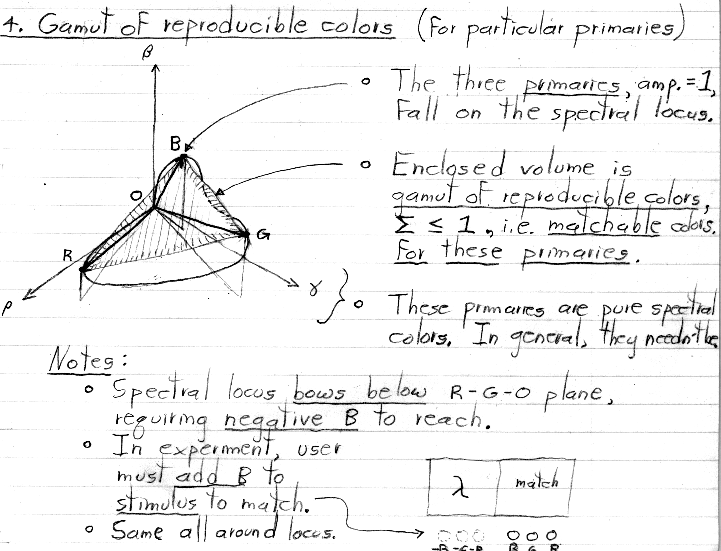
CS 248 - Introduction to Computer Graphics
Autumn Quarter, 2001
Marc Levoy
Lecture notes for Thursday, October 4











Initially, this is the same situation as depicted in the previous section (#3), except that we make it a point to choose pure spectral colors whose amplitude=1 points lie roughly on the red, green, and blue parts of the spectral locus. We are also allowing mixtures of these R,G,B primaries whose sum lies between zero and one, rather than being normalized to one. This leads to colors that occupy the volume between the shaded plane and the origin. This volume is called the gamut of reproducible colors for these particular primaries.
If the R,G,B primaries are not pure spectral colors (i.e. single wavelengths), then they can be represented as mixtures of pure spectral colors. In this case, their amplitude=1 points will fall somewhere strictly inside the volume shaded above, rather than falling on the spectral locus. The gamut of colors reproducible using these non-pure primaries will shrink accordingly, to span these new points.
Finally, remember that the primaries don't need to be in the red, green, and blue parts of the spectral locus. Choosing different wavelengths (or mixtures of wavelengths) as primaries will move the amplitude=1 points (and the corresponding gamut) around. However, the gamut will always fall within the convex hull ("shrink-wrap") of the spectral locus, because that represents all the (normalized) responses possible in our visual system, and therefore the full range of colors we humans can see.

The rho-gamma-beta response space we have been considering so far represents
mixtures of primaries whose sum is no greater than one. In the RGB cube
diagrammed immediately above, setting two or three guns to full amplitude
(value=255) violates this assumption. Thus, to visualize this cube plotted in
rho-gamma-beta space, you must lower the light output corresponding to the
R=255, G=255, and B=255 points in the RGB cube until the white point
(R=G=B=255) falls within the convex hull of the spectral locus.



